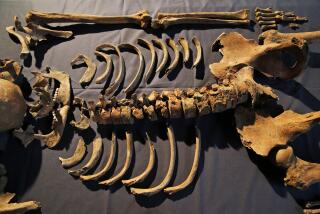HIV dates back to circa 1900, researchers say
- Share via
A genetic analysis of a biopsy sample recently discovered in the Democratic Republic of the Congo has led researchers to conclude that the virus that causes AIDS has existed in human populations for more than a century, according to a study released Wednesday.
The study, led by evolutionary biologist Michael Worobey of the University of Arizona in Tucson, puts the date of origin at around 1900, which is 30 years earlier than previous analyses.
HIV-1, the most common form of the virus, is known to have originated in chimpanzees because of close genetic similarities to a simian virus. It now infects an estimated 33 million people worldwide.
But figuring out when the virus jumped species and became established in humans has been difficult. The first cases in the U.S. were recognized in 1981, and the oldest evidence of the virus is a 1959 blood sample taken from a man who lived in what was then the Belgian Congo.
To find the point of origin, the scientists relied on a well-recognized genetic technique to determine the mutation rates of different sub-types of the virus. With a known rate of mutation, researchers could then, in essence, run the clock backward to find the point where the different sub-types were the same. That common ancestor would represent the first appearance of the virus in humans before it mutated.
“The HIV virus evolves incredibly quickly,” said geneticist Bette Korber of Los Alamos National Laboratory in New Mexico, who did an analysis in 2000. “Those mutations get passed on to the next individual. So we have that evolutionary pace to enable a look backward.”
Korber’s analysis compared the 1959 blood sample and modern samples. She traced their common ancestor to roughly 1931.
The new analysis, published in the journal Nature on Wednesday, added lymph node tissue from a woman who died in 1960 in the Belgian Congo. The tissue specimen was one of more than 800 preserved in ice-cube-size blocks of paraffin at the University of Kinshasa.
The researchers compared that sample with modern strains to determine its mutation rate. Then they matched that rate with the 1959 sample, tracing their common ancestor to between 1884 and 1924.
“I’ve been trying to track down old samples like this for quite a few years now,” Worobey said. “As soon as you have that one other sequence from that same time period, it really snaps the whole evolutionary picture into sharp focus.”
The researchers surmised that the creation of colonial cities around the turn of the century was the catalyst that allowed the virus to take hold.
Dr. Steven M. Wolinsky, a co-author of the study, said that colonial cities meant not just more potential hosts for viruses living in closer quarters, but also prostitution and other high-risk behaviors for transmitting the virus.
“Urbanization was probably the main trigger,” said Wolinsky, an infectious diseases specialist at the Feinberg School of Medicine at Northwestern University in Chicago.
Jim Moore, an anthropologist at UC San Diego who was not associated with the study, said the fact that the virus could have spread unnoticed for decades is no surprise, given the mortality rates in Africa during the colonial period.
“The conditions then were horrendous in terms of how Africans were treated,” he said. “People dying of AIDS would have been part of the background.”
--





